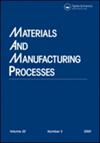High aspect ratio shaped microtool fabrication using sheet-EDG
IF 4.7
2区 材料科学
Q2 ENGINEERING, MANUFACTURING
引用次数: 0
Abstract
ABSTRACT Micro EDM is a tool-based micromachining process for fabricating micro-features on metallic surfaces. The existing microtool fabrication techniques are complex and require an additional setup, which increases the cost. This study proposed a simple and cost-effective method called sheet electrical discharge grinding (sheet-EDG). A 500 μm diameter tungsten carbide rod was radially fed and later reciprocated along a 100-μm-thick brass sheet to fabricate high aspect ratio (AR) microtools without any noticeable taper. The effects of process parameters, such as optimal tool path, radial infeed positions, sheet thickness, sheet-EDG parameter, radial infeed per pass, radial infeed rate, and traverse feed rate were investigated and discussed. Further, two microtools with average diameter of 28 μm and 23 μm, having AR of more than 50 and 100, respectively, were fabricated. Finally, different shaped-microtools were fabricated based on modified tool paths. The results demonstrate that sheet-EDG technique can fabricate high AR microtools with different end shapes.KEYWORDS: Shaped-microtoolmicro-EDMsheet-EDGbrass sheettungsten carbidetool path Disclosure statementNo potential conflict of interest was reported by the author(s).高纵横比形状的微刀具制造使用薄板edg
微细电火花加工是一种基于刀具的金属表面微细加工工艺。现有的微工具制造技术很复杂,需要额外的设置,这增加了成本。本文提出了一种简单、经济的薄片放电磨削方法。将直径为500 μm的碳化钨棒径向送入,然后沿100 μm厚的黄铜片往复往复,制备出无明显锥度的高长径比(AR)微刀具。研究并讨论了最佳刀具轨迹、径向进给位置、薄板厚度、薄板- edg参数、每道次径向进给量、径向进给速度和横向进给速度等工艺参数的影响。制备了平均直径为28 μm和23 μm的微刀具,其AR值分别大于50和100。最后,根据修改后的刀具轨迹制备出不同形状的微刀具。结果表明,薄片电火花加工技术可以制造出具有不同端形的高AR微刀具。关键词:成形-微刀具-微edmsheet - edgbrass sheet-钨-碳化硅-刀具路径披露声明作者未报告潜在的利益冲突。
本文章由计算机程序翻译,如有差异,请以英文原文为准。
求助全文
约1分钟内获得全文
求助全文
来源期刊

Materials and Manufacturing Processes
工程技术-材料科学:综合
CiteScore
9.00
自引率
22.90%
发文量
132
审稿时长
3.4 months
期刊介绍:
Materials and Manufacturing Processes deals with issues that result in better utilization of raw materials and energy, integration of design and manufacturing activities requiring the invention of suitable new manufacturing processes and techniques, unmanned production dependent on efficient and reliable control of various processes including intelligent processing, introduction of new materials in industrial production necessitating new manufacturing process technology, and more. Information is offered in various formats, including research articles, letter reports, review articles, conference papers, applied research, book and conference reviews, and entire issues devoted to symposia.
All submitted manuscripts are subject to initial appraisal by the Editors, and, if found suitable for further consideration, to peer review by independent, anonymous expert referees. All peer review is single blind and submission is online via ScholarOne Manuscripts.
 求助内容:
求助内容: 应助结果提醒方式:
应助结果提醒方式:


